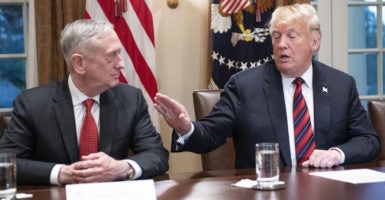With Democrats regaining control of the House of Representatives, the path to rebuilding America’s military just became more challenging.
For the past two years, Pentagon officials have laid out in stark detail how the military had deteriorated over the past decade, owing to underfunding and overuse in two protracted conflicts.
Shortly after he arrived at the Pentagon, Secretary of Defense James Mattis testified that he was shocked at the poor state of the military’s readiness.
Many people are surprised to learn that the Army, Navy, and Air Force are the smallest they have been since 1950. Some recall how capable our military was during the first Gulf War in 1991, but don’t realize that the military that so ably ejected Saddam Hussein from Kuwait is now two-thirds the size it was then.
The modernization of our nuclear deterrent—missiles, submarines, and bombers—has been continually postponed and delayed to the point now where our service members are often using equipment, such as 8-inch floppy drives, that rightfully belongs in museums, not on the front lines of our defenses.
Crippling budget cuts related to the Budget Control Act essentially delayed an entire new generation of military equipment.
The Heritage Foundation’s 2019 Index of U.S. Military Strength describes a military currently crippled by shortages of pilots, low readiness rates of aircraft, and substandard training for sailors.
None of these facts is in real dispute. It’s how the nation chooses to deal with this reality that is now in question.
The Trump administration released a new national defense strategy in January, the first real defense strategy the country has had for 10 years. The strategy makes a clean break from the past by clearly identifying China and Russia as the U.S.’ primary strategic competitors for the foreseeable future.
Iran, North Korea, and terrorism are also mentioned, but take a back seat to the other two.
The implications for the U.S. military are profound, and the armed forces must now quickly reorient themselves to be able to counter the two most formidable adversaries in the world.
When releasing the strategy, Mattis was careful to caution that in order to implement it, the Defense Department would need “sustained and predictable investment to restore readiness and modernize our military.”
Without that investment, he said, “We will rapidly lose our military advantage, resulting in a joint force that has legacy systems irrelevant to the defense of our people.”
That brings us to the situation in Congress. Both the House and Senate with strong bipartisan support voted to approve the president’s requests to add desperately needed additional funding to the military for 2017, 2018, and 2019.
Tens of billions of dollars have been added to the defense budget, which is already having a visible effect toward increasing the readiness of our forces. More jet fighters, Navy ships, and quantities of munitions are now flowing into the force.
It’s a beginning. But the military did not get into this situation overnight, and it’s going to take many years to rebuild it to the point where it’s able to implement the new defense strategy.
That’s why continued and sustained congressional support is crucial to the military’s rebuilding, and that in turn is why recent remarks on defense issues by the presumptive new chairman of the House Armed Services Committee, Rep. Adam Smith, D-Wash., are so concerning.
Smith has gone on record opposing increased defense spending, stating that the 2019 budget of $716 billion is “too high” and that he would like to see it lowered. He also has expressed his opposition to modernizing our nuclear deterrent or increasing the size of our Navy to the number of ships the Pentagon has said is needed.
Providing for the common defense of the nation should be a bipartisan priority. Our nation’s defenses have deteriorated to the point where they are unequal to the tasks we have given them.
Hopefully, in the coming months, the administration and both houses of Congress can work together to address this issue. As Mattis likes to say, “America can afford survival.”






























